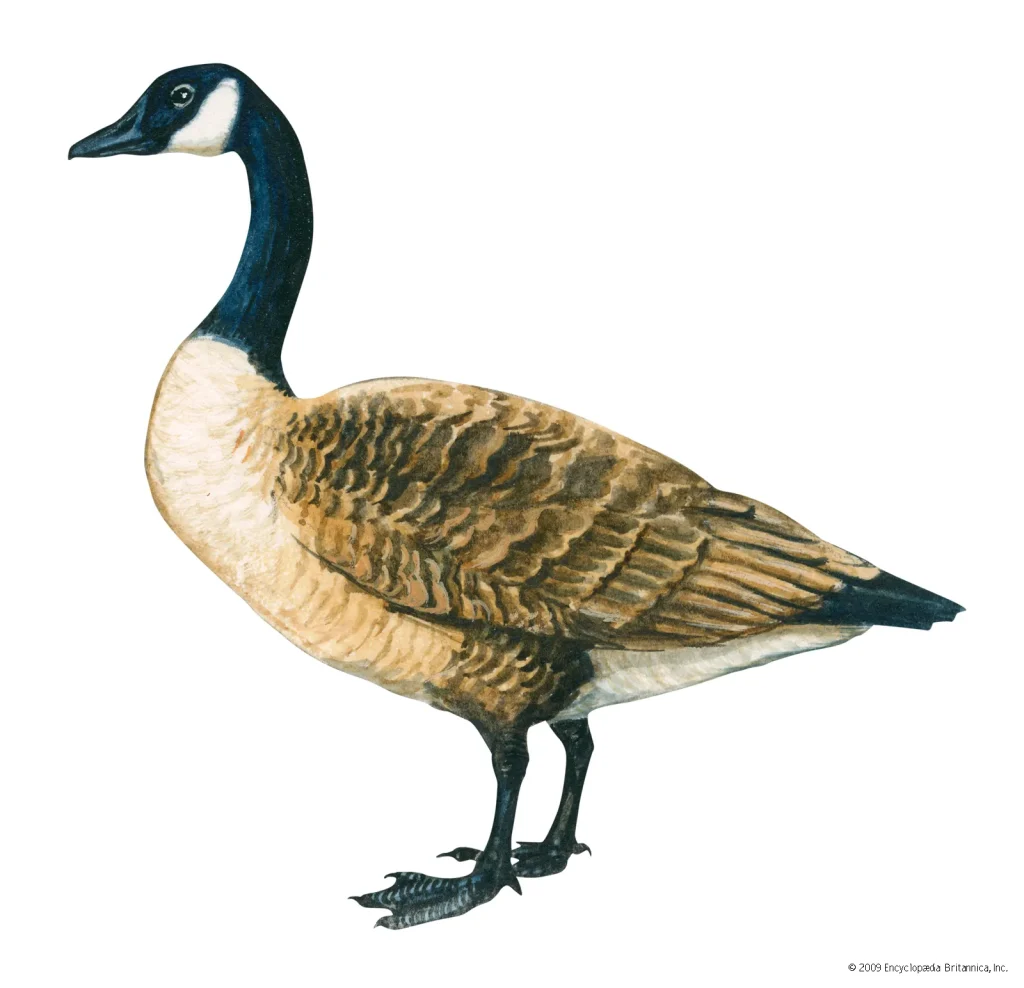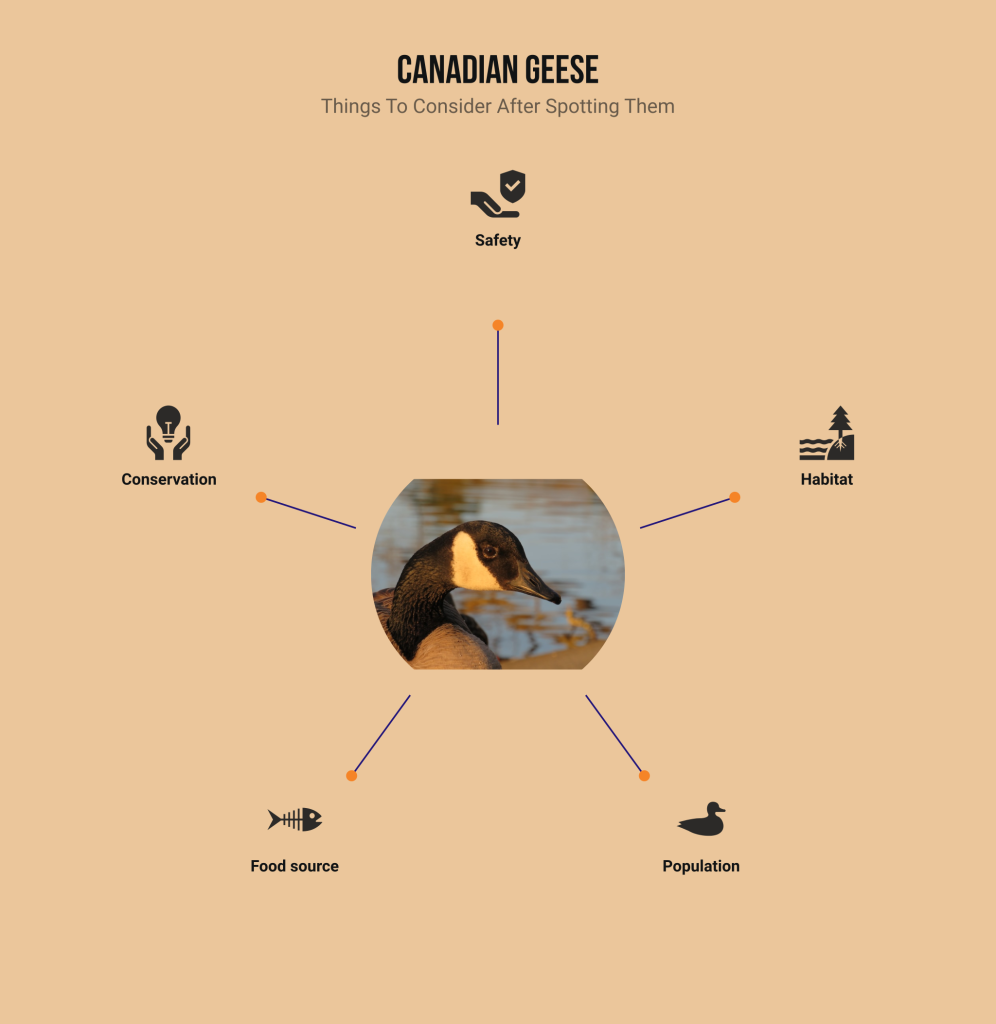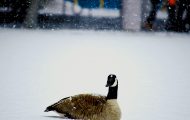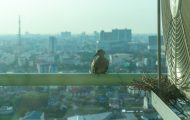Frequently found in numerous regions of Canada, Canadian geese are recognizable through their unique vocalizations, which frequently resound over waterways and parklands. Despite their appearance as benign creatures, people often ask, “Are Canadian geese aggressive?”. Given that these birds possess sizable physiques complemented by pointed beaks and powerful wings, coupled with an innate defensiveness towards their offspring and dwellings, it is understandable why such inquiries arise regarding whether or not Canadian geese can actually cause harm. This blog will explore and clarify any uncertainties surrounding potential threats posed by encounters with wild Canadian geese, so keep reading!
Physical Characteristics of Canadian Geese

🟦 Size
Canadian geese, with a length of up to 43 inches (109 cm) and weight of up to 14 pounds (6.5 kg), belong among the biggest goose species known worldwide. Their massive size makes identifying them an effortless task that doesn’t require any specialized skills.
Furthermore, it sets them apart from other popular goose breeds as well. By getting bigger relative to how much space they take up, they are better able to withstand cold weather and keep their body heat for longer. This is mostly because of how big they are, not because of biological determinism or adaptations to it, which don’t have a big effect on how heat moves.
🟦 Color
Canadian geese possess a notable black neck and head with an accompanying white chinstrap. In contrast, their body is generally brownish-gray. Their distinctiveness can easily be attributed to their starkly contrasting colors.
The chinstrap provides a sharpness against their dark feathers, while their gray-brown plumage helps them naturally blend into vegetation such as grasses. Some birds in this species group have white patches on their wings and bellies that make them easy to tell apart from other birds in the same species group.
🟦 Beak
The Canadian goose’s beak is small and dark because it is designed to break up plant matter like grasses and grains, which make up a large part of their diet. Furthermore, the slight bend at the end enables them to snip leaves or small branches from shrubs or trees with ease.
🟦 Eyes
Canadian geese have eyes that are circular in shape and dark in color. These eyes, which are on opposite sides of the goose’s head, give it a wide view of its surroundings so it can spot danger. In addition to this ability, Canadian geese have adapted structures in their eyes that allow them to see both above and below water. This gives them the ability to move around in both air and water environments.
🟦 Legs
Canadian geese have long, black legs that are good for both swimming in the water and walking on land. Their webbed appendages ably assist in propelling them through the water’s surface, while their extended lower limbs permit shallow-water traversal or land-based mobility. Additionally, these same webbed feet provide invaluable stability during nautical navigation amidst rough currents.
🟦 Wingspan
Canadian geese are popular for their remarkable flying abilities, which is due to their impressive wingspan that measures between 50 and 70 inches (127-178cm). Their sturdy and wide wings enable them to soar through the skies with ease. These majestic birds possess the lift and vigor required for prolonged flights, making long-distance travel over hundreds of miles seem effortless during migration season.
🟦 Feathers
The cozy, protecting plumage of Canadian geese enables them to withstand frigid environments. Their feathers are close together, which keeps a warm layer of air close to their bodies and protects them from the cold. In addition to keeping them warm in cold weather, the quills also keep water droplets from sticking to them. This makes it easier for them to swim or dive without getting wet. Aside from this, the puffin also assists in keeping itself buoyant, allowing effortless movement through aquatic habitats.
Common Behaviors of Canadian Geese

🟫 Migration
Migratory birds, particularly Canadian geese, undertake extensive journeys in autumn and spring to locate nourishment sources and areas appropriate for procreation. When migrating, they often fly together in the formation of a V. This helps them preserve energy levels even as they travel longer routes than the normal distances achievable by individual birds alone. During their travels, these feathered creatures maintain communication through various vocalizations, such as honking sounds, among themselves while airborne.
🟫 Pair bonding
Commonly, Canadian Geese are loyal to their mates, pairing for life. Throughout the mating season, they exhibit various courtship behaviors, including vocalizations, head movements, and preening activities. It’s common for male and female geese to bond by grooming each other as well as lightly tapping their beaks with one another. Following this bonding process comes the initiation of nesting procedures.
🟫 Nesting
Canadian geese often nest in proximity to water. The female lays a batch of eggs, which both parents take turns incubating. Roughly a month passes before they emerge from their shells and goslings come into existence. Caring parents keep them cozy, nourish them, and safeguard them against those who prey upon them. This is done until they can fend for themselves after several weeks. During this time instructions are given regarding swimming techniques as well as how to acquire food independently.
🟫 Aggression
During the time of year when Canadian geese are breeding, they can become territorial and act aggressively. They may produce a hissing or honking sound while also potentially charging toward perceived threats, which include humans. This pattern is due to their instinctual desire to safeguard both nests and offspring.
If any potential danger arises, they will react by using either their wings or beaks for the attack. To avoid conflict, it’s crucial that an adequate amount of space separate the animal from any supposed invader, as the interaction could result in injury on one or more fronts.
🟫 Vocalizations
The boisterous vocalizations of Canadian geese are infamous for their communication among the flock. They have an array of different sounds that they create, such as grunts, whistles, and growls, to convey important messages amongst themselves. These noises serve vital functions in helping them communicate with their partners while also acting as a warning signal when there is potential danger ahead during migration season. This is to make them stick together tightly at all times.
🟫 Grazing
Canadian geese are animals that consume only plants. They have a diet mainly consisting of greens, seeds, and flora native to their natural habitat. Most of the time, these birds look for food in large groups, which could hurt or destroy gardens or crops. This is evident as at times these waterfowl can devour up to 4 pounds of vegetation in one day. It’s highly recommended by experts not to feed them under any circumstances. This is because such practices may trigger dependence on humans, eventually leading to overpopulation issues among the species.
🟫 Socializing
The Canadian goose likes to hang out with other birds in its flock, so it often gathers with them. People see these gatherings while the birds are migrating or while they are feeding themselves. Among their leisure time activities, the geese will occasionally partake in swimming and diving sessions for recreation purposes as well. When breeding season arrives, each goose pairs up. Thus, they become more possessive over their territory. Conversely, outside of this period, large groups consisting of hundreds formed again to prevent territorial limitations.
Are Canadian Geese Aggressive?
Yes, Canadian geese are known to show aggression. This is particularly true in their nesting season, which spans from March until June. They have a natural instinct to protect their nests and their young, and they would not hesitate to fight off intruders on their territory if they felt threatened.
The size of the Canadian geese is quite imposing and can instill fear. Their talons and beaks are capable of inflicting damage, just as they possess powerful wings. In addition to their physique, they tend to hiss and create noise by flapping their wings, honking, or charging toward any potential threat.
During the time when Canadian geese are nesting, it is crucial to respect their boundaries and not encroach upon them. If you have to walk by where these birds are nesting, it would be best to keep a safe distance from them so you don’t bother them too much.
When passing through such regions, try moving at a leisurely pace without causing any sudden movements that might startle the creatures in question, while also taking care not to create loud noises around them, which could cause unnecessary concern for your safety on top of disrupting theirs.
Feeding Habits of Canadian Geese
🟩 Grasses and Sedges
Throughout the summer months, Canadian geese tend to gravitate towards consuming grasses and sedges that are abundant during this time. They will leisurely graze on these plants while uprooting them to take a bite. The types of vegetation they seem particularly drawn to include smooth cordgrass, switchgrass, and saltgrass. All of these can often be seen growing within wetlands or meadows. These greenery options prove essential for providing the birds with an array of vital nutrients, including fiber quantities alongside assorted minerals and vitamins.
🟩 Aquatic Plants
Canadian geese consume a variety of aquatic flora that predominantly thrives in ponds, lakes, and other water reservoirs. They exhibit the ability to submerge themselves into these bodies of water for easy access to their food source. Aquatic plants give birds many important nutrients, such as vitamins A and C, and minerals, such as magnesium, calcium, and potassium, which help the birds grow and develop. Their diet is inclusive but not limited to duckweed, algae, and pondweed, alongside various strains of lilies found on these watery haven points.
🟩 Grains and Seeds
During the fall and winter months, when grasses and aquatic plants become scarce, Canadian geese shift their diet to grains and seeds. They feed on a variety of grains including corn, wheat, barley, and oats, which are often found in agricultural fields. They also feed on seeds such as those from sunflowers, goldenrod, and other plants. These grains and seeds are an important source of carbohydrates and fats which help the geese to build up their energy stores for migration or the colder months.
🟩 Human Food
The Canadian goose is known for eating whatever it can find, so it’s no surprise that it likes to scavenge human food where it lives in cities. The geese can consume various snacks given by people, including bread and popcorn. Although these foods do not pose any threats when consumed in small quantities, the consumption of such unnatural foods may cause health issues among the birds, leading to problems with their digestive systems or malnutrition if relied upon too frequently.
Feeding them regularly can also lead to a loss of fear towards humans, making it dangerous and inconvenient. However, it is recommended that we avoid offering them human meals at all costs and instead feed them what they would typically eat on their own accord whenever possible.
Things To Consider When Spotting Canadian Geese

🟪 Safety
Canadian geese commonly display territorial and hostile behaviors. This is particularly when it’s nesting season, which is typically from March to June. During this period of time, these birds become intensely defensive over safeguarding their nests and goslings so that they can seize on humans or other creatures who intrude too closely.
The utmost priority should be keeping a sufficient safety gap between yourself and the bird. You must not advance toward them nor try feeding the goose. If one happens upon an aggressive goose, refrain from hurrying back. Instead, slowly retract while allowing adequate space for the animal to move about freely without feeling threatened while maintaining your own personal safety at heart.
🟪 Habitat
Wetlands, which include ponds, rivers, and lakes, are where Canadian geese usually reside. It is uncommon to see them in cities or suburbs because this indicates that things like development, habitat loss, or pollution have altered their natural habitats. In these circumstances, it may become essential for alternative shelter options to be provided or steps taken towards restoring natural habitats. This is to make Canadian geese thrive again without any disruptions to the environment they were once used to.
🟪 Population
During recent years, the number of Canadian geese has noticeably increased, which raises worries regarding their influence on nature and other animals. Even though this progression shows that conservation efforts are working, it may cause too much in some areas. This surplus can lead to excessive grazing along with damage and greenery annihilation, resulting in amplified levels of waste as well as contamination. If you are perceiving a lot of geese in your vicinity, it might be advisable to inspect if the population is sustainable or if any conservation methods have been implemented.
🟪 Food sources
The Canadian geese consume mainly greenery, like grasses and water plants. If there aren’t many places to eat nearby, it could mean that the environment isn’t good for them. This would mean that they need help. This help can come in the form of giving them other food options or putting native plants back into their ecosystem. You must not forget, though, that nourishing these creatures could influence their dependency on humans and disrupt their typical feeding habits.
🟪 Conservation efforts
Numerous initiatives exist for safeguarding Canadian geese and their environments. As part of these efforts, habitats could be fixed up, the number of birds could be kept in check, or there could be educational campaigns to teach people how to be kind around these birds. Those looking to participate can explore nearby conservation groups or opportunities for volunteering within their localities.
Furthermore, it remains imperative to notify local wildlife organizations or authorities whenever any form of harassment towards these animals is observed with corresponding harm inflicted upon them as well.
Final Words
In summary, despite being frequently seen in parks and outdoor areas, it’s critical to keep in mind that Canadian geese can exhibit aggressiveness, especially during breeding or when they perceive danger. It is optimal to provide ample space for these avian creatures and not get too close to their young or nest homes. By acting with care and admiration toward them, we may continue to cherish the beauty of this species while safeguarding our safety and that of those close to us.
(Next featured bird? Attic birds! Click here to learn if they are safe or not for your family.)



